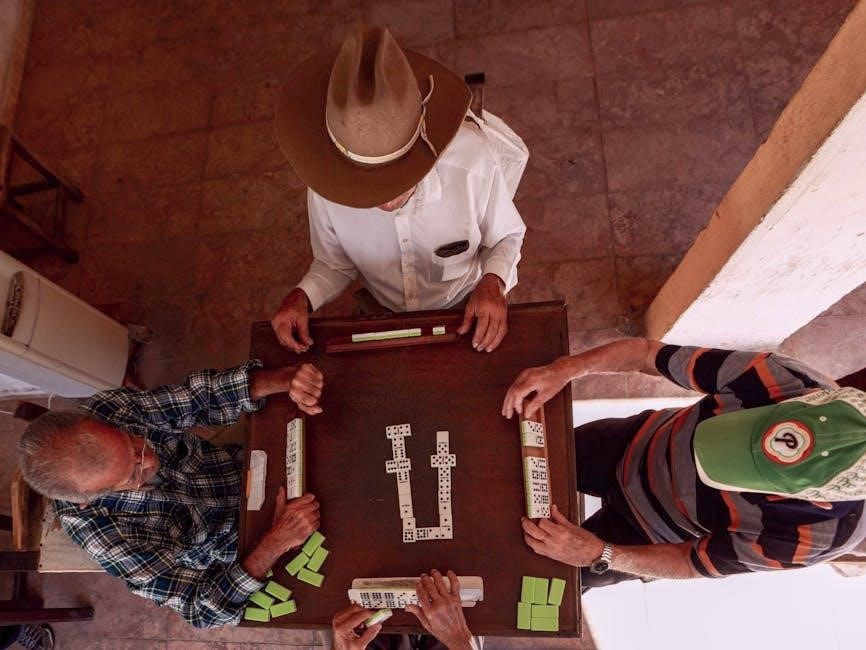Discover the official dominoes rules in a comprehensive PDF guide, perfect for learning basic strategies, variations, and scoring systems. Start playing with confidence today!
Overview of the Dominoes Game
The dominoes game is a classic tabletop activity played with 28 tiles, each featuring pairs of numbers from 0 to 6. The objective is to place tiles in a specific order, earning points based on opponents’ inability to play. The game is simple yet strategic, with variations like Five-Up and Chicken Foot offering unique twists. Players can download an official Dominoes Game Rules PDF to learn detailed instructions, strategies, and variations. This guide covers basic rules, setup, and scoring systems, making it ideal for both newcomers and experienced players. Whether you’re playing solitaire or with friends, the PDF ensures a clear understanding of the game’s fundamentals and advanced techniques.
Why Dominoes is a Popular Game
Dominoes remains a beloved game due to its simplicity and universal appeal. Its straightforward rules, such as matching numbers on tiles, make it accessible to all ages. The availability of an official Dominoes Game Rules PDF ensures players can easily learn and master the game. With variations like Chicken Foot and All Fives, dominoes offers diverse gameplay options, keeping it exciting for both casual and competitive players. Additionally, its portability and minimal equipment requirements make it a convenient choice for gatherings. The game also enhances cognitive skills like memory and strategy, further contributing to its enduring popularity. Downloading the PDF guide allows anyone to join in, making dominoes a timeless favorite worldwide.

Basic Rules of Dominoes
Dominoes is played with 28 tiles, each numbered from 0 to 6. Players match tiles to earn points, with rules detailed in the official Dominoes Game Rules PDF.
Objective of the Game
The primary goal in dominoes is to be the first player to lay down all your tiles. Points are scored based on the tiles your opponents cannot place. The game ends when one player runs out of tiles or no more legal moves can be made. The winner is the player with the lowest total score, calculated by summing the pips on unused tiles. Official rules, including scoring systems and game conclusion criteria, are detailed in the Dominoes Game Rules PDF, ensuring clarity for players of all skill levels.
Number of Players
Dominoes can be played with two to four players, depending on the variation. Standard games typically involve two players, while others allow three or four players, either individually or in teams. According to the Dominoes Game Rules PDF, the most common setup is for two players, with each drawing seven tiles from the double-six set. In games with three or four players, the number of tiles drawn decreases to ensure there are enough tiles for all participants. Official rules also accommodate variations like partner games, where teams of two compete against each other. The flexibility in player count makes dominoes accessible and enjoyable for different group sizes.
Equipment Needed
To play dominoes, you need a standard set of dominoes, also known as “bones.” The most common set is the double-six, which contains 28 tiles. Larger sets like double-nine or double-twelve are also used in some variations. Each tile has two ends with pips (dots) ranging from 0 (blank) to the highest number in the set. A flat playing surface, such as a table, is essential. Players also need a domino tray or rack to organize their tiles during the game. According to the Dominoes Game Rules PDF, the official equipment includes the dominoes set and a suitable playing area. No additional tools are required beyond the tiles and a surface to play on.
Setup and Initial Preparation

According to the Dominoes Game Rules PDF, the setup begins with shuffling the domino tiles face down on a flat surface. Players then draw a specific number of tiles, depending on the version of the game. In most cases, each player receives 5-7 tiles. The remaining tiles are placed face down in a pile, known as the “boneyard,” and serve as the draw pile. The first tile is typically placed by the player who drew the highest double. Players then take turns matching tiles to the ends of the line of play. The setup ensures fairness and prepares the game for smooth play, as outlined in the official rules.

How to Play Dominoes
Drawing Tiles
In dominoes, players begin by drawing tiles from the boneyard, a face-down pile of unused tiles. The number of tiles drawn depends on the number of players and the specific variant. Typically, 2-4 players draw 5-7 tiles each. The remaining tiles stay in the boneyard. If a player cannot make a move, they may draw a tile from the boneyard, but this is optional in some rules. Drawing tiles ensures players have options to play and keeps the game flowing. The goal is to have the right tiles to match the pips on the table. Always remember, drawing tiles is a strategic part of the game that can lead to new opportunities or challenges.
Determining the First Player
At the start of a dominoes game, the first player is typically determined by a random method to ensure fairness. The most common approach is for each player to draw one tile from the boneyard. The player with the tile containing the highest number of pips goes first. Alternatively, a coin toss can be used, where heads grants the first turn to one player and tails to another. In some variations, the player holding the heaviest double (e.g., double six) is given the privilege of starting. The method chosen should be agreed upon by all players beforehand to maintain a balanced and enjoyable game. This random selection ensures no player has an unfair advantage at the outset.
Matching Tiles
In dominoes, players take turns placing tiles by matching the number of pips on one end of a tile to the pips on an open end of a tile already in play. The tile must align perfectly, with the matched numbers facing each other. Doubles are placed perpendicular to the line of play, with one half of the double connected to the existing tile. Players can extend the line of play in either direction by matching their tiles appropriately. If a tile is placed incorrectly, it is considered a foul, and the player may lose their turn or points. The game continues until one player runs out of tiles or no legal moves remain, at which point the game progresses toward its conclusion.
Passing a Turn
In dominoes, if a player cannot legally place a tile, they must pass their turn. This typically occurs when there are no tiles in their hand that match the pips on either end of the domino chain. If the game allows, some rules permit players to draw a tile from the boneyard before passing, but this depends on the specific variation being played. Passing a turn does not necessarily mean the player is out of the game; they can re-enter if the domino chain changes in a way that allows them to play a tile later. Passing is a strategic part of the game and ensures play continues smoothly. Always consult the official dominoes rules PDF for clarification on passing rules.
End of the Game
The game of dominoes concludes under specific conditions. It ends when one player runs out of tiles or when no more legal moves can be made. If a player cannot make a move and no tiles remain in the boneyard, they must pass, and if all players pass consecutively, the game ends. The final score is calculated by counting the pips on the opponents’ remaining tiles, and the player with the lowest total points wins. In some variations, the game ends when a player reaches a predetermined score, such as 100 or 200 points. The official dominoes rules PDF provides detailed guidelines for ending the game and declaring a winner.
Scoring in Dominoes
Scoring in dominoes involves counting pips on tiles. Points are awarded based on the total pips left in opponents’ hands. The winner’s score is the difference.
Points System
In dominoes, the points system is straightforward, with each pip on a tile representing one point. Players earn points by laying tiles that match the pips on the board. The goal is to accumulate points by creating matches and forcing opponents to draw tiles. Some variations start scoring at a base of 100 or 200 points to extend gameplay. Each round’s winner earns points equal to the difference in pips between their tiles and their opponents’. The game typically ends when a player reaches a predetermined score, such as 100, 200, or 500 points, depending on the variation being played.
The points system encourages strategic play, as players aim to minimize their opponents’ scoring opportunities while maximizing their own. Understanding the points system is crucial for tracking progress and declaring the winner. Each variation of dominoes may slightly tweak the scoring rules, but the core idea remains consistent across all versions.
Counting Pips
Counting pips is a critical aspect of scoring in dominoes. Each tile features two ends with numbered pips, ranging from 0 (a blank) to 6. The total number of pips on both ends determines the tile’s value. During gameplay, players must count the pips on the tiles they lay to accumulate points. At the end of each round, the pips on all played tiles are summed to calculate the score. In some variations, players also count pips on unused tiles in their opponents’ hands, which can add to their own score. Accurate pip counting is essential for fair play and determining the winner. Players often use a scoreboard or mental tally to keep track of points throughout the game. This system ensures transparency and fairness in scoring.
Winning the Game
Winning the game is determined by reaching a predetermined number of points or by being the first player to lay down all their tiles. The game typically ends when one player runs out of tiles or when no more valid moves can be made. At this point, players calculate their scores based on the pips remaining in their opponents’ hands. The player with the lowest total score wins. If all tiles are drawn and no player has won, the game continues until a winner is decided. In most variations, the standard winning score is set at 200 or 250 points. The player who reaches or exceeds this score first is declared the winner.
Penalties and Foul Play
Penalties and foul play in dominoes ensure fair gameplay and uphold the rules. Common penalties include drawing tiles incorrectly or failing to match pips properly, resulting in losing a turn or earning extra points. Miscounting pips or laying tiles out of order may also incur penalties. Foul play involves cheating, such as hiding tiles or lying about moves, leading to disqualification or forfeiting the game. Players must act honestly to maintain integrity. Penalties enforce adherence to rules, while foul play undermines fair competition. Understanding these guidelines helps maintain a respectful and enjoyable game environment.

Strategies and Tips
Strategies involve memorizing tiles, blocking opponents, and knowing when to pass. Effective play enhances your chances of winning consistently in dominoes.
Basic Strategies for Beginners
Mastering basic strategies is key to improving your dominoes game. Start by understanding tile matching and scoring rules. Memorize which tiles have been played to anticipate opponents’ moves. Focus on creating multiple scoring opportunities while blocking opponents from doing the same. Keep a balanced set of tiles to maintain flexibility in your plays. Pay attention to the board layout to spot potential matches early. Learn when to pass strategically to avoid holding unwanted tiles. Practice these fundamentals consistently to build a solid foundation for more advanced play.
- Memorize tiles to track remaining plays.
- Plan moves to maximize scoring chances.
- Block opponents by limiting their options.
- Know when to pass to avoid penalties.
These strategies will help beginners improve quickly and enjoy the game more.
Advanced Techniques
Advanced players use sophisticated strategies to outmaneuver opponents. One key technique is tile tracking, where you memorize which tiles have been played to predict opponents’ remaining options. Another is manipulating the board to create multiple scoring opportunities while limiting opponents’ moves. Forcing opponents to draw tiles by leaving specific matches can also gain an advantage. Additionally, “baiting” involves playing a tile that appears beneficial but actually traps opponents. Keeping a versatile set of tiles ensures flexibility, while focusing on high-pip tiles can maximize scoring. Mastering these advanced techniques requires practice and sharp observation.
- Track tiles to predict opponents’ moves.
- Create multiple scoring opportunities.
- Force opponents to draw tiles strategically.
- Use baiting to deceive opponents.
These advanced methods elevate gameplay for experienced players.

Psychological Aspects
Dominoes is as much a game of psychology as it is of skill. Experienced players often use mental tactics to influence opponents’ decisions. Reading body language, tone, and reactions can reveal clues about opponents’ tiles. Bluffing, such as acting confident with a weak hand, can intimidate opponents. Conversely, remaining calm under pressure can unsettle rivals. Mental endurance is key, as the game requires focus over extended periods. Players must also manage their emotions, avoiding frustration during setbacks. Understanding these psychological dynamics can significantly enhance gameplay and strategic decision-making.

- Read opponents’ body language and reactions.
- Bluff to deceive opponents about your tiles.
- Maintain focus and emotional control.
Mastering psychological aspects can give players a competitive edge.
Common Mistakes to Avoid
When playing dominoes, several common mistakes can hinder your success. One of the most frequent errors is rushing to play tiles without planning ahead. Players often overlook the importance of tracking which tiles have been played, leading to missed opportunities. Another mistake is failing to pay attention to opponents’ moves, which can reveal their remaining tiles. Additionally, new players often forget to communicate clearly about the tiles they hold, causing confusion in team games. Overlooking rules, such as doubting the pip count or miscounting the score, can result in penalties. Lastly, frustration when unable to play can lead to poor decisions. Avoiding these mistakes improves gameplay and overall enjoyment.
- Rushing to play without planning ahead.
- Not tracking tiles that have been played.
- Ignoring opponents’ moves and strategies.
- Forgetting to communicate clearly in team play.
- Overlooking rules and miscounting scores.
- Letting frustration influence decision-making.
Avoiding these errors ensures a smoother and more enjoyable game.

Variations of Dominoes
Dominoes offers numerous variations, each with unique rules and strategies. Popular versions include All Fives, Chicken Foot, Block Dominoes, and Spanish Dominoes, ensuring diverse gameplay experiences.
- All Fives
- Chicken Foot
- Block Dominoes
- Spanish Dominoes
All Fives
All Fives is a popular dominoes variation where scoring is based on making the total pips in open ends equal to five. Players earn points by laying tiles that achieve this. Each time a player creates a multiple of five, they score points. The game starts with the highest double, and players alternate turns. The objective is to be the first to lay all tiles or have the lowest hand at the end. Bonus points are awarded for winning the game. All Fives requires strategic planning to maximize points and minimize opponents’ scoring opportunities. It’s a fast-paced variant that emphasizes quick thinking and pip management. The game ends when one player runs out of tiles or no legal moves remain. The winner is the player with the highest score. Penalties may apply for illegal moves or failing to pass when unable to play. All Fives is a skill-based game that combines luck and strategy, making it a favorite among experienced players. The rules are well-documented in official dominoes guides, ensuring clarity for newcomers and veterans alike. By mastering All Fives, players can enhance their overall dominoes skills and enjoy competitive gameplay.
Chicken Foot
Chicken Foot is a dominoes variation that uses a double-12 or double-9 set. The game starts with a central tile, and players build “legs” or lines from it. Each leg must match the pips on the central tile. The number of legs typically equals the number of players. Points are scored by forcing opponents to draw tiles. The game ends when one player runs out of tiles or no legal moves remain. The winner is the player with the lowest score. Chicken Foot emphasizes strategy, as players must balance completing their own legs with disrupting opponents. Official rules are detailed in dominoes guides, making it easy to learn. This variant is popular for its dynamic gameplay and competitive nature, appealing to both casual and experienced players. Mastery requires skill and adaptability to outmaneuver opponents effectively.
Block Dominoes
Block Dominoes is a popular variation where players start with a set number of tiles, typically three to seven, depending on the number of players. The goal is to be the first to lay down all your tiles. Players take turns matching tiles to the ends of the line, similar to standard dominoes. If a player cannot make a move, they must pass their turn; The game ends when one player runs out of tiles or no legal moves are left. Points are scored based on the total pips left in opponents’ hands. Block Dominoes emphasizes strategy, as players must carefully plan their moves to outlast opponents. Official rules are outlined in dominoes game guides, ensuring clarity for players; This variant is known for its simplicity and fast-paced nature, making it a favorite among dominoes enthusiasts. Mastering tile counting and memory can give players a competitive edge in this thrilling game.
Spanish Dominoes
Spanish Dominoes is a dynamic variation played with a double-12 set, making it more extensive than standard games. It typically involves 2 to 4 players, each starting with 7 tiles. The game begins with the highest double being played first, and players alternate turns, matching tiles to open ends. Spanish Dominoes emphasizes speed and strategy, as players must think quickly to outmaneuver opponents. The game ends when one player runs out of tiles or no legal moves remain. Points are scored based on the total pips left in opponents’ hands. This variation is known for its fast-paced action and higher complexity due to the larger set. Official rules are detailed in dominoes game rules PDFs, providing clear guidelines for players. Spanish Dominoes is a favorite among experienced players seeking a challenging and engaging experience.

Official Rules and Resources
Official dominoes rules and resources are available online, providing comprehensive guides for gameplay, scoring, and variations. These resources ensure consistency and fair play across all games.
Where to Find Official Rules
Official dominoes game rules can be found on reputable websites, such as the World Domino Federation or official dominoes game portals. These platforms offer downloadable PDF guides that detail gameplay, scoring, and variations. Many retailers that sell dominoes sets also include rulebooks or provide links to official resources. Additionally, online forums and communities dedicated to dominoes often share PDF versions of the rules for easy access. These resources are typically free and cover everything from basic gameplay to advanced strategies, ensuring players have a consistent understanding of the game.
Downloading Dominoes Rules PDF
Downloading a dominoes rules PDF is straightforward and convenient. Visit official dominoes websites or platforms like the World Domino Federation, which offer free downloadable guides. Many gaming forums and community sites also provide PDF versions of the rules. Ensure the source is reputable to avoid incorrect or outdated information. Some retailers include downloadable rules with dominoes purchases. Once downloaded, the PDF serves as a handy reference for learning and teaching others. Always verify the source to ensure accuracy and avoid potential security risks associated with unofficial downloads. This document is ideal for players seeking clarity on gameplay, scoring, and variations.
Understanding the PDF Guide
The dominoes rules PDF provides a comprehensive guide to understanding the game. It typically includes detailed explanations of setup, gameplay, and scoring systems. The guide is structured clearly, with sections on basic rules, variations, and advanced strategies. Visual aids like diagrams and illustrations often accompany the text to clarify complex concepts. The PDF also outlines penalties and foul play, ensuring players adhere to official standards. Many guides include examples of common scenarios to help learners grasp the rules practically. The document is designed to be user-friendly, with clear headings and an index for easy navigation. Whether you’re a beginner or an experienced player, the PDF offers a valuable resource to enhance your understanding of dominoes.
Mastering dominoes begins with understanding its rules. This guide provides a clear roadmap, from setup to scoring, ensuring a fun and competitive experience for all players.

The dominoes game is a strategic and entertaining activity that involves matching tiles with corresponding pips. A standard game typically includes 2 to 4 players, and the objective is to accumulate points by creating valid matches. The game begins with a setup where players draw tiles, and the first player is determined by the highest double tile. Players take turns matching tiles, and the game ends when one player runs out of tiles or no more valid moves are possible. Points are scored based on the total pips left on opponents’ tiles. Strategies like planning ahead and understanding scoring systems can enhance gameplay. Different variations, such as All Fives or Block Dominoes, offer unique twists. Official rules and resources are available in PDF guides for those seeking detailed instructions. Understanding these key points ensures a smooth and enjoyable experience for all players.
Encouragement to Play
Dominoes is a timeless and engaging game that offers fun for players of all ages and skill levels. Its simplicity makes it accessible to beginners, while its strategic depth appeals to experienced players. Whether you’re playing with family, friends, or in a competitive setting, dominoes fosters camaraderie and healthy competition. Learning the rules through a PDF guide is a great way to start, as it provides a clear and concise foundation. Don’t hesitate to give dominoes a try—it’s a rewarding hobby that sharpens your mind and brings people together. Grab some tiles, invite others, and enjoy the excitement of this classic game!